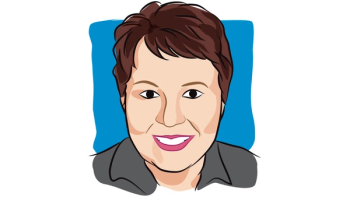
Despite Huge Changes, the "Best Is Yet to Come" in Myeloma
While there have been many recent groundbreaking advances in treating myeloma, Kenneth C. Anderson is optimistic that the future holds even more promise.
With seven new treatments approved in 2015 for the treatment of multiple myeloma, there is significant reason for optimism, says Kenneth C. Anderson.
At the 2016 meeting of the National Comprehensive Cancer Network (NCCN), CURE interviewed Anderson to review these changes and talk about what's next.
How have the NCCN guidelines for multiple myeloma changed in the past year?
What has changed in the definition of myeloma and who can benefit from treatment?
How has staging patients with myeloma changed?
How has treatment changed? We'll start with newly diagnosed patients.
Anderson is the program director of the Jerome Lipper Multiple Myeloma Center and LeBow Institute for Myeloma Therapeutics at Dana-Farber Cancer Institute.It's been a truly remarkable year in multiple myeloma. We've been blessed — we've had 16 new FDA-approved treatments in the last 12 years and in 2015, alone, we had seven new treatments. The 2016 version of the NCCN guidelines is completely revised.Traditionally, we've waited for CRAB features — hypercalcemia, renal dysfunction, anemia and bone lesions — to be present before treating patients. We know now that even in the absence of these features, patients are eligible for therapy. Active myeloma now includes more patients and smoldering myeloma is a smaller category.Traditionally, we've used the International Staging System (ISS), which is based on beta-2 microglobulin and albumin. Now, we have the revised ISS, which uses not only beta-2 microglobulin and albumin but also incorporates high-risk cytogenetic abnormalities.Once patients have been diagnosed and staged, we treat them. For the newly diagnosed transplant patient, this year in the NCCN guidelines we have Revlimid (lenalidomide), Velcade (bortezomib) and dexamethasone — the triplet — as a Category 1 recommendation, based on phase 3 evidence showing superiority. We also have another triplet — Revlimid, Velcade and Ninlaro (ixazomib) — as an option for treatment, based on a phase 2 trial. This triplet is exciting because it's an all oral regimen.
What about relapsed patients-- how has treatment changed?
In the non-transplant, newly diagnosed patient, this progress is also reflected. Both of these triplets are included as options. For relapsed patients with myeloma, there are eight different changes to the guidelines this year. While that might sound confusing or daunting, it's the best development we could possibly have. We now have new agents in classes we already know about, but also new agents in completely new classes of drugs.
In immunomodulatory drugs, we previously had Pomalyst (pomalidomide) and dexamethasone. Now, Pomalyst and dexamethasone have been moved into the Category 1 recommendation setting because of additional phase 3 evidence showing superiority in relapsed/refractory patients.
In the proteasome inhibitor category, we have Kyprolis (carfilzomib) and dexamethasone included in the guidelines based on a randomized trial of the agents compared with Velcade and dexamethasone — the so-called ENDEAVOR trial — showing superiority. We also have Kyprolis, Revlimid and dexamethasone as an option for patients with one to three prior therapies. Finally, Ninlaro, Revlimid and dexamethasone was approved late last year. Lots of changes in the proteasome inhibitor category.
Also in the relapsed setting, we have two new classes of agents. The histone deacetylase (HDAC) inhibitor called Farydak (panobinostat) was approved in combination with Velcade and dexametasone.
Most excitingly, we have immune therapies — we have two monoclonal antibodies. The first is called Empliciti (elotuzumab) and it targets an antigen called SLAMF7 that is widely expressed on myeloma. As a single agent, this antibody did not achieve significant responses, but combined with Revlimid and dexamethasone in a large, randomized trial, the combination was superior to just Revlimid and dexamethasone. It was approved in late 2015.
Last but not least, Darzalex (daratumumab) — an antibody that targets CD38 — achieved 30 percent response rates as a single agent, which led to its approval. It is also now being combined with Revlimid and dexamethasone.
What is the key takeaway from all of this-- for patients and survivors, but also oncologists and oncology nurses?
To summarize all of this, in 2016 we have a new definition of who should be treated, we have a new staging system and we have new therapies for both newly diagnosed and relapsed patients.
In myeloma, as in other cancers, no one drug is going to be enough. We have 8,000 mutations in myeloma cells of a newly diagnosed patient. When myeloma returns, there are 12,000 mutations and they're not the same ones. We need all of these new drugs and it's an exciting time because they all have different mechanisms. The immune therapies, not alone but in combination with other therapies, especially, are very exciting.
It's been a record year. I think patients are destined to do better, still. In my opinion, the best is yet to come.





